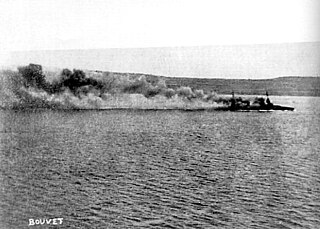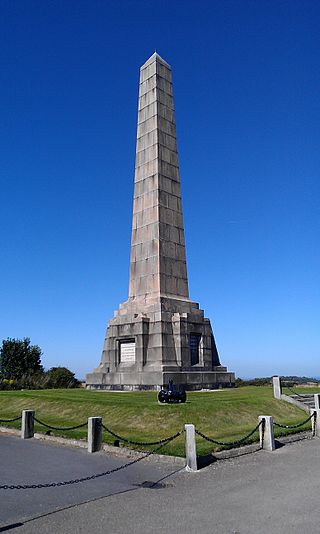
HMS Canopus was a pre-dreadnought battleship of the British Royal Navy and the lead ship of the Canopus class. Intended for service in Asia, Canopus and her sister ships were smaller and faster than the preceding Majestic-class battleships, but retained the same battery of four 12-inch (305 mm) guns. She also carried thinner armour, but incorporated new Krupp steel, which was more effective than the Harvey armour used in the Majestics. Canopus was laid down in January 1897, launched in October that year, and commissioned into the fleet in December 1899.

The naval operations in the Dardanelles campaign took place against the Ottoman Empire during the First World War. Ships of the Royal Navy, French Marine nationale, Imperial Russian Navy and the Royal Australian Navy, attempted to force a passage through the Dardanelles Straits, a narrow, 41 mi-long (66 km) waterway connecting the Mediterranean Sea with the Sea of Marmara and the Black Sea further north.

The British Mediterranean Fleet, also known as the Mediterranean Station, was a formation of the Royal Navy. The Fleet was one of the most prestigious commands in the navy for the majority of its history, defending the vital sea link between the United Kingdom and the majority of the British Empire in the Eastern Hemisphere. The first Commander-in-Chief for the Mediterranean Fleet was the appointment of General at Sea Robert Blake in September 1654. The Fleet was in existence until 1967.

HMS Cornwallis was a Duncan-class pre-dreadnought battleship of the Royal Navy. Built to counter a group of fast Russian battleships, Cornwallis and her sister ships were capable of steaming at 19 knots, making them the fastest battleships in the world. The Duncan-class battleships were armed with a main battery of four 12-inch (305 mm) guns and they were broadly similar to the London-class battleships, though of a slightly reduced displacement and thinner armour layout. As such, they reflected a development of the lighter second-class ships of the Canopus-class battleship. Cornwallis was built between her keel laying in July 1899 and her completion in February 1904.

The Dover Patrol and later known as the Dover Patrol Force was a Royal Navy command of the First World War, notable for its involvement in the Zeebrugge Raid on 22 April 1918. The Dover Patrol formed a discrete unit of the Royal Navy based at Dover and Dunkirk for the duration of the First World War. Its primary task was to prevent enemy German shipping—chiefly submarines—from entering the English Channel en route to the Atlantic Ocean, thereby obliging the Imperial German Navy to travel via the much longer route around Scotland which was itself covered by the Northern Patrol.
The 3rd Battle Squadron was a naval squadron of the British Royal Navy consisting of battleships and other vessels, active from at least 1914 to 1945. The 3rd Battle Squadron was initially part of the Royal Navy's Home Fleet. During the First World War, the Home Fleet was renamed the Grand Fleet. During the Second World War, the squadron covered Atlantic convoys.

The Battle Cruiser Fleet, (BCF), later known as Battle Cruiser Force, a naval formation of fast battlecruisers of the Royal Navy, operated from 1915 to 1919.

HMS Pincher was a coal-fired Beagle-class destroyer of the Royal Navy built by William Denny and Brothers and launched on 15 March 1910.

The First Cruiser Squadron was a Royal Navy squadron of cruisers that saw service as part of the Grand Fleet during World War I, then later as part of the Mediterranean during the Interwar period and World War II. It was first established in 1904 and existed until 1952.
The Second Fleet was a reserve formation of the Royal Navy that briefly existed before the First World War.
HMS Beagle was one of sixteen destroyers ordered under the 1908–09 Naval Estimates from John Brown & Company of Clydebank. Named for the English hunting dog, she was the sixth ship to carry this name since it was introduced for a Cruizer Class fir-built, brig-sloop on 8 August 1804 and sold on 21 July 1814. The destroyers of the 1908–09 program would be the last coal-fired destroyers of the Royal Navy. She and her sisters served in the First Destroyer Flotilla then were moved en masse to the Third Destroyer Flotilla and before the start of the Great War to the Fifth Destroyer Flotilla. With the advent of the convoy system they were moved to the Second Destroyer Flotilla. With the Armistice she was laid up then scrapped in 1921.

The Deputy First Sea Lord (D.F.S.L.) was a senior Royal Navy flag officer on the Board of Admiralty of the Royal Navy.

The British Adriatic Squadron, or simply the Adriatic Squadron and later known as the British Adriatic Force, was a military formation of the Mediterranean Fleet during World War I based at Taranto from 1915–19.
The 2nd Division was a naval formation of the British Home Fleet it was formed before First World War in March 1909 until May 1912.
The Flag Officer-in-Charge, Humber was a Royal Navy officer who administered naval forces located at Immingham and Grimsby, Lincolnshire, England. His formation was sometimes known as the Humber Station or Humber Area. In World War I it was a sub-command of the Admiral of Patrols from 1914 to 1916, then came under the Commander-in-Chief at the Nore until 1921. In World War II the FOIC was responsible to the Commander-in-Chief, The Nore.

The British 4th Destroyer Flotilla , or Fourth Destroyer Flotilla, was a naval formation of the Royal Navy from August 1909 to July 1951.
The British 10th Destroyer Flotilla, or Tenth Destroyer Flotilla, was a military formation of the Royal Navy from March from 1914 to 1919. It was reformed on an ad hoc basis from 1940 to 1941 and finally from 1944 to 1945.

In the Royal Navy, a principal naval transport officer (P.N.T.O.) later known as principal sea transport officer (P.S.T.O.) is a shore-based flag officer or captain responsible for sea transport duties, and assisting the senior naval officer's area of command in the preparation of naval orders and conduct disembarkations. British Dominion Navies also used the concept.
In the Royal Navy, a Divisional Transport Officer (DTO) or a Divisional Naval Transport Officer (DNTO) and later called a Divisional Sea Transport Officer (DSTO) is a shore-based naval officer responsible for the efficient working of the transports and boats of the flotilla, division or squadron under his charge.

The Black Sea and Caspian Squadron, also known as the Black Sea and Marmora Force and the Black Sea and Marmora Division, was a naval formation of the British Mediterranean Fleet from 1918 to 1919.









